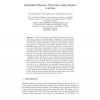Free Online Productivity Tools
i2Speak
i2Symbol
i2OCR
iTex2Img
iWeb2Print
iWeb2Shot
i2Type
iPdf2Split
iPdf2Merge
i2Bopomofo
i2Arabic
i2Style
i2Image
i2PDF
iLatex2Rtf
Sci2ools
DIMVA
2008
2008
Embedded Malware Detection Using Markov n-Grams
Embedded malware is a recently discovered security threat that allows malcode to be hidden inside a benign file. It has been shown that embedded malware is not detected by commercial antivirus software even when the malware signature is present in the antivirus database. In this paper, we present a novel anomaly detection scheme to detect embedded malware. We first analyze byte sequences in benign files to show that benign files' data generally exhibit a 1-st order dependence structure. Consequently, conditional n-grams provide a more meaningful representation of a file's statistical properties than traditional n-grams. To capture and leverage this correlation structure for embedded malware detection, we model the conditional distributions as Markov n-grams. For embedded malware detection, we use an information-theoretic measure, called entropy rate, to quantify changes in Markov n-gram distributions observed in a file. We show that the entropy rate of Markov n-grams gets sig...
| Added | 29 Oct 2010 |
| Updated | 29 Oct 2010 |
| Type | Conference |
| Year | 2008 |
| Where | DIMVA |
| Authors | M. Zubair Shafiq, Syed Ali Khayam, Muddassar Farooq |
Comments (0)

